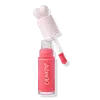What's inside
What's inside
 Key Ingredients
Key Ingredients

 Benefits
Benefits

 Concerns
Concerns

 Ingredients Side-by-side
Ingredients Side-by-side

Hydrogenated Polyisobutene
EmollientIsododecane
EmollientSqualane
EmollientDisteardimonium Hectorite
StabilisingSilica
AbrasiveEthylene/Propylene/Styrene Copolymer
Octyldodecanol
EmollientNiacinamide
SmoothingPropylene Carbonate
SolventSodium Polyglutamate
HumectantRicinus Communis Seed Oil
MaskingSodium Hyaluronate
HumectantHelianthus Annuus Seed Wax
Skin ConditioningDiethylhexyl Syringylidenemalonate
Skin ProtectingPhenoxyethanol
PreservativeCaprylic/Capric Triglyceride
MaskingButylene/Ethylene/Styrene Copolymer
Caprylyl Glycol
EmollientEthylhexylglycerin
Skin ConditioningHexylene Glycol
EmulsifyingPentaerythrityl Tetra-Di-T-Butyl Hydroxyhydrocinnamate
AntioxidantChondrus Crispus
MaskingAlumina
AbrasiveTriethoxycaprylylsilane
Iron Oxides
CI 15850
Cosmetic ColorantCI 77891
Cosmetic ColorantCI 19140
Cosmetic ColorantHydrogenated Polyisobutene, Isododecane, Squalane, Disteardimonium Hectorite, Silica, Ethylene/Propylene/Styrene Copolymer, Octyldodecanol, Niacinamide, Propylene Carbonate, Sodium Polyglutamate, Ricinus Communis Seed Oil, Sodium Hyaluronate, Helianthus Annuus Seed Wax, Diethylhexyl Syringylidenemalonate, Phenoxyethanol, Caprylic/Capric Triglyceride, Butylene/Ethylene/Styrene Copolymer, Caprylyl Glycol, Ethylhexylglycerin, Hexylene Glycol, Pentaerythrityl Tetra-Di-T-Butyl Hydroxyhydrocinnamate, Chondrus Crispus, Alumina, Triethoxycaprylylsilane, Iron Oxides, CI 15850, CI 77891, CI 19140
Dimethicone
EmollientBis-Diglyceryl Polyacyladipate-2
EmollientPhenyl Trimethicone
Skin ConditioningNylon-12
Kaolin
AbrasiveDiisostearyl Malate
EmollientHydrogenated Polyisobutene
EmollientDimethicone Crosspolymer
Emulsion StabilisingVinyl Dimethicone/Methicone Silsesquioxane Crosspolymer
Butyrospermum Parkii Butter
Skin ConditioningGlycerin
HumectantCI 77120
Cosmetic ColorantAlumina
AbrasiveAluminum Hydroxide
EmollientCaprylyl Glycol
EmollientTocopherol
AntioxidantTocopheryl Acetate
AntioxidantSorbic Acid
PreservativePhenoxyethanol
PreservativeCI 15850
Cosmetic ColorantCI 77491
Cosmetic ColorantCI 77492
Cosmetic ColorantCI 77499
Cosmetic ColorantCI 77891
Cosmetic ColorantCI 19140
Cosmetic ColorantCI 42090
Cosmetic ColorantDimethicone, Bis-Diglyceryl Polyacyladipate-2, Phenyl Trimethicone, Nylon-12, Kaolin, Diisostearyl Malate, Hydrogenated Polyisobutene, Dimethicone Crosspolymer, Vinyl Dimethicone/Methicone Silsesquioxane Crosspolymer, Butyrospermum Parkii Butter, Glycerin, CI 77120, Alumina, Aluminum Hydroxide, Caprylyl Glycol, Tocopherol, Tocopheryl Acetate, Sorbic Acid, Phenoxyethanol, CI 15850, CI 77491, CI 77492, CI 77499, CI 77891, CI 19140, CI 42090
Ingredients Explained
These ingredients are found in both products.
Ingredients higher up in an ingredient list are typically present in a larger amount.
Alumina is another name for the compound aluminum oxide. It is used as a thickener, absorbent, and abrasive.
As an absorbent, alumina can give a mattifying effect. It is used in mineral sunscreens to help coat nano-sized filters, such as titanium dioxide. By increasing the size of the UV filters, these ingredients stay on the skin for a longer time. By coating small sized ingredients, alumina helps thicken a product.
Alumina may be used as an abrasive, or exfoliant.
Alumina is naturally occurring in the mineral corundum. Certain varieties of corundum create rubies and sapphires. Corundum is also the crystalline form of alumina.
Learn more about AluminaCaprylyl Glycol is a humectant and emollient, meaning it attracts and preserves moisture.
It is a common ingredient in many products, especially those designed to hydrate skin. The primary benefits are retaining moisture, skin softening, and promoting a healthy skin barrier.
Though Caprylyl Glycol is an alcohol derived from fatty acids, it is not the kind that can dry out skin.
This ingredient is also used as a preservative to extend the life of products. It has slight antimicrobial properties.
Learn more about Caprylyl GlycolCi 15850 is the pigment color red. It is an azo dye and created synthetically.
Azo dyes need to be thoroughly purified before use. This allows them to be more stable and longer-lasting.
This ingredient is common in foundations, lipsticks, and blushes. This color is described as brown/orangey red.
It has many secondary names such as Red 6 and Red 7. According to a manufacturer, Red 6 usually contains aluminum.
Learn more about CI 15850CI 19140 is also known as Tartrazine. Tartrazine is a synthetic dye used in cosmetics, foods, and medicine to add a yellow color.
Tartrazine is created from petroleum and is water-soluble.
Some people may experience allergies from this dye, especially asthmatics and those with an aspirin intolerance.
Learn more about CI 19140Ci 77891 is a white pigment from Titanium dioxide. It is naturally found in minerals such as rutile and ilmenite.
It's main function is to add a white color to cosmetics. It can also be mixed with other colors to create different shades.
Ci 77891 is commonly found in sunscreens due to its ability to block UV rays.
Learn more about CI 77891Hydrogenated Polyisobutene is a synthetic polymer. Polymers are compounds with high molecular weight. Hydrogenated Polyisobutene is an emollient and texture enhancer.
In one study, Hydrogenated Polyisobutene showed better skin hydration levels than Caprylic/Capric Triglyceride. As an emollient, it helps keep your skin soft and hydrated by trapping moisture in.
Hydrogenated Polyisobutene is often used as a mineral oil replacement.
Learn more about Hydrogenated PolyisobutenePhenoxyethanol is a preservative that has germicide, antimicrobial, and aromatic properties. Studies show that phenoxyethanol can prevent microbial growth. By itself, it has a scent that is similar to that of a rose.
It's often used in formulations along with Caprylyl Glycol to preserve the shelf life of products.